Subsidies to railway companies
To encourage the growth of the railway network the government often offered a financial contribution for every kilometre of track laid, even when such inducements were not necessary, in the form of payment of customs dues. The resulting documents were not paper currency (as they were not generally negotiable) but occasionally appears in auctions of bonds, and at least one, that of the Ferrocarril Central Mexicano, in appearance resembles a banknote more than a bond.
El Ferrocarril Central Mexicano
In the early 1880s, several entrepreneurs of Boston, who owned the Atchison, Topeka and Santa Fe railway, in their eagerness to extend its routes beyond the U.S. border, were organized to set up a new company called the Compañía Limitada del Ferrocarril Central Mexicano. This new company had as its objective to build a railway from Mexico City to the Texas border, with branches to Salvatierra, Dolores Hidalgo, Guadalajara, San Luis Potosí and a point on the Pacific coast. The concession, granted to Sebastían Camacho and Ramón G. Guzmán, representing the company, was approved by the Mexican Congress on 8 September 1880El Siglo Diez y Nueve, Año XXXIX, Tomo 78, Núm. 12674, but the works had already started months before. With the signing of the contract the government undertook to hand over to the company $9,500 per kilometre built, and granted it a period of two years for the termination of the stretch from Mexico City to León, another five years to finish the line to the Pacific and eight for Paso del Norte (Ciudad Juárez).
The company opened the main line in March 1884, linking Mexico City to Ciudad Juárez and connections to the Southern Pacific Railroad, Texas and Pacific Railway, and Atchison, Topeka and Santa Fe Railway. Other major branches included Irapuato to Guadalajara (completed in 1888), Chicalote to Tampico (completed in 1890), and Guadalajara to Manzanillo (completed in 1908).
The relevant articles of the contract stated that the subsidy was to begin to be paid, at the completion of the first 150 kilometres of the line and thereafter at the completion of sections of 25 kilometres. The subsidy would be in the form of non-interest bearing obligations, entitled " Certificados de construcción de ferrocarriles”, which would be amortized with six percent of all the duties raised in the maritime and border customs. This 6% would not be accepted in cash or in any other kind other than the indicated paper, if available, under penalty of being subject to a second payment. The company was obliged to place in all the towns where there were customs posts, these certificates in sufficient quantity that people could obtain them. The company could not sell them for more than their stated value (but did sell them, at a discount, to the Banco Nacional de México, who in turn sold them to importers).
Two different sets of specimens are known. They have different fonts, red four or blue five digit serial numbers, and. most obviously, a vignette of [ ] or [ ].
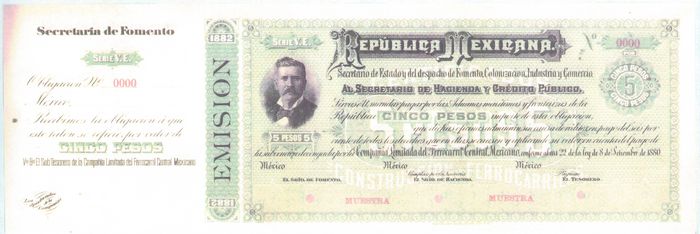
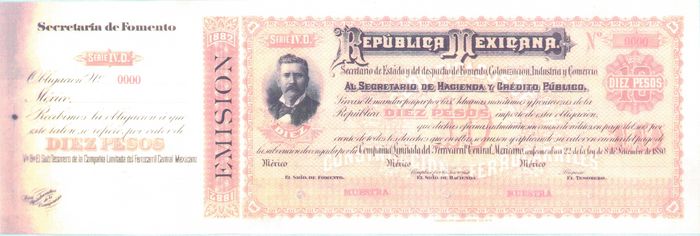

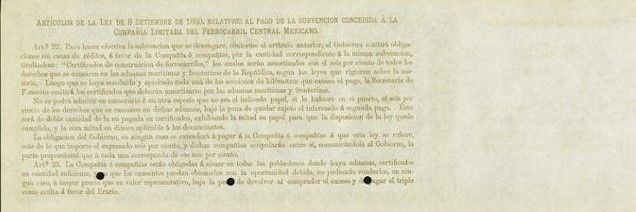

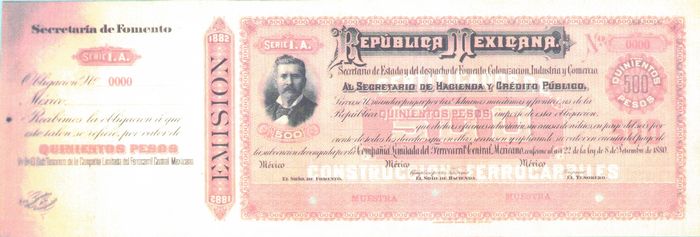
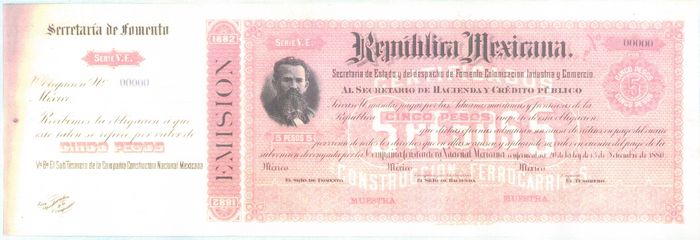

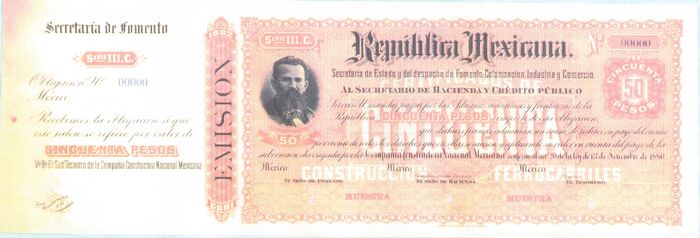

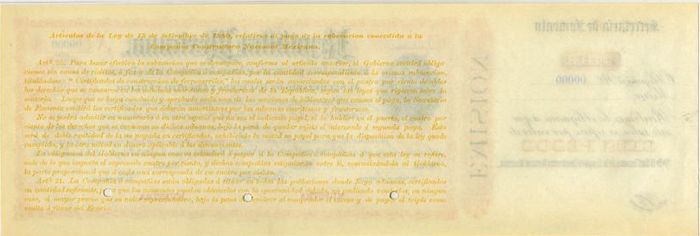
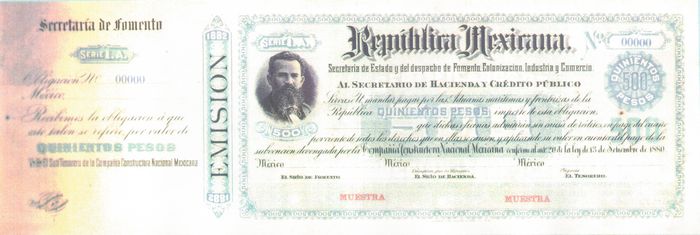
| series | from | to | total number |
total value |
||
| $5 | VE | |||||
| $10 | IVD | |||||
| $50 | IIIC | |||||
| $100 | IIB | |||||
| $500 | IA |
The relevant articles 22 and 23 are reproduced on the reverse of the note.
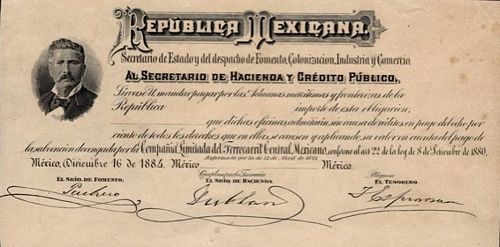
This proof from the first set has no denomination but does have the signatures of Carlos Pacheco as Secretario de Fomento, Colonización e Industria, Manuel Dublan as Secretario de Hacienda y Crédito Público and [ ] Espinosa as Tesorero and an additional 'Reformado por la de 12 de Abril de 1882' referring to an amendment to the original concession.
Chihuahua
The Chihuahua state government also gave the Ferrocarril Central Mexicano a subsidy for the line between Parral and the Chihuahua-Durango border.
The Compañía Constructora Nacional Mexicana
Five days later the government signed a similar contract (but with 4% rather than 6% of the customs receipts) with James Sullivan, of the Compañía Constructora Nacional Mexicana, for the construction of two lines, one from Mexico City to Manzanillo on the Pacific coast and another to the northern frontier at Nuevo LaredoLa Libertad, Año III, Núm. 210, 16 September 1880; El Siglo Diez y Nueve, Año XXXIX, Tomo 78, Núm. 12678, 20 September 1880. Sullivan and his partner, William. J. Palmer, owned the Denver and Rio Grande Railroad.
Construction work began on 14 October 1880, but less than three years later it was suspended as insufficient capital and the difficulty of linking the Denver and Rio Grande with their Mexican concession in Laredo caused Palmer and Sullivan to lose interest in the line. On 23 May 1886, they sold their stake in the company to Eckstein Norton, representative of the Compañía del Ferrocarril Nacional Mexicano — a company with a strong presence of English capital —, thanks to which it was possible to finish the trunk line on 1 November 1887. In May 1901 the company was purchased by Speyer & Company of New York, which meant the displacement of British capital by American capital, and a new change in the name of the company to Ferrocarril Nacional de México. Just two years after the purchase was made, Speyer acceded to the request of the Secretario de Hacienda, José Y. Limantour, to merge the Ferrocarril Nacional de México with the Ferrocarril Interoceánico, giving control of both to the Mexican government.
According to a decree of 10 January 1883 the company was offered a subsidy, amortizable with 6% of customs receipts. These were among the various certificates being offered for sale by the Campeche agency of the Banco Nacional de México by November 1884Períodico Oficial, Campeche, 21 November 1884.
The Compañía Ferrocarril Interoceánico de Acapulco á Veracruz
By a contract dated 13 February 1883 the government consolidated eight concessions granted between 16 April 1883 and 21 January 1882 into a single one, granted to Francisco Arteaga, representing the Compañía del Ferrocarril Interoceánico de Acapulco, Morelos, México, Irolo y VeracruzEl Siglo Diez y Nueve, Año XLII, Tomo 83, Núm 13461, 24 March 1883. Previous contracts had specified a subsidy of $8,000 per kilometre, to be paid in a manner deemed appropriate by the Tesorería General de la Nación. On 3 July 1883 the company changed its name to Compañía del Ferrocarril Interoceánico de Acapulco á Veracruz.
| series | from | to | total number |
total value |
||
| $50 | IIB | 1 | 600 | |||
| $100 | IA | 1 | 500 |
On 16 March 1888 Francisco Espinosa reported that he had already issued 600 $50 certificates (numbered 1-600) and 500 $100 (numbered 1-500)Boletín del Ministerio de Hacienda, 16 March 1888.
On 26 May 1890 the government agreed an additional $200,000 in certificados, provided the company opened its line between Mexico City and Veracruz before 5 May 1891.
El Ferrocarril Chihuahua al Pacífico
The Chihuahua state government issued bonds for the Chihuahua al Pacífico railroad.
